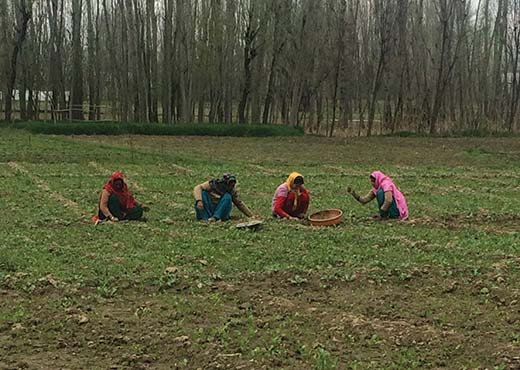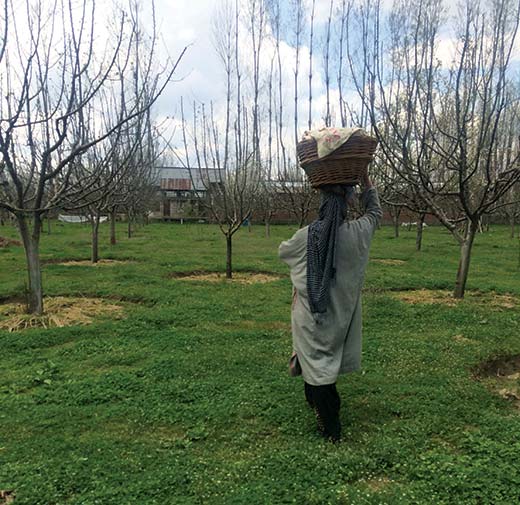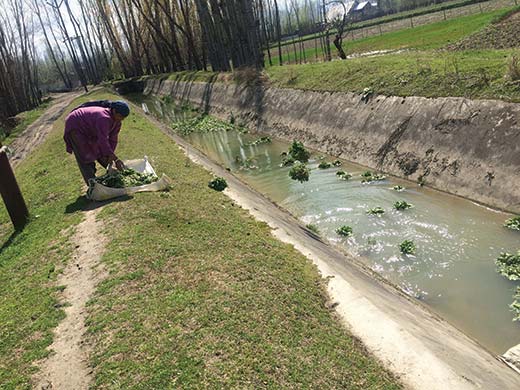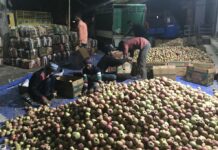Urbanization forced city vegetable growers look for cheap land and labour in the periphery. Bugam in Budgam had both. But as outsiders started reaping benefits, natives followed to make it big in vegetables. Saima Bhat reports
In last two decades, sixty-year-old Ghulam Qadir Dar has seen his fortunes change dramatically. In 1995, despite owning two kanals of fertile agriculture land in his native village of Bugam, district Budgam – some 9 km from Srinagar – Dar would work as a daily labourer to feed his family.
That year, a Dander (vegetable grower), from Batmaloo’s Danderkha Mohallah in Srinagar, approached him to get his agriculture land on lease. “He wanted to grow vegetables instead of rice on that land, something that sounded absurd. But the money he was offering was too good to be turned down,” recalls Dar.
Dar would on and off lease that piece of land to a local brick kiln owner for extraction of soil to make bricks. The income generated from soil extraction, some Rs 5000 a year, would keep Dar and his family going during hard time.
The Dander from Srinagar offered him Rs 14000 a season for growing vegetables on his land plus he asked Dar to work for him. For next 5 years, Dar worked in his own fields growing vegetables as a labourer against a meagre sum that was paid by his employer. “During this time I learned a lot about vegetables. I learnt how you can grow a different set of vegetables on the same land one after another,” says Dar.
Around the same time, in Srinagar’s Batmaloo area, which was the main feeder of vegetables for city markets, massive population explosion forced natives to turn their once profitable vegetable gardens into housing colonies.
“Not so long ago there used to be lush green vegetable gardens everywhere in this area,” says Bilal Khan, a resident of Danderkha Mohallah, in Batmaloo, Srinagar.
The change forced Danders (community mainly associated with vegetable cultivation) to look for cheaper land outside Srinagar to carry on with their livelihood. And Bugam, which is just 9 km from Srinagar, with its low land prices and cheap labour became an apparent choice. Within no time many vegetable growers from Batmaloo started buying or renting land in Bugam. They would also engage locals like Dar for the cultivation of vegetables from this impoverished village of Budgam district.
By the turn of the century, in 2000, after learning the art of growing vegetables, Dar decided to work on his fields on his own. “I could see how much money he was making out of my 2 kanals by just growing vegetables,” says Dar. “I then terminated our rent contract and started working on my fields on my own.”
That proved game changer for Dar. Soon he started working on his fields, not just as a labourer but as the owner of the produce.
There were many others in Bugam like Dar who after witnessing the green revolution created by outsiders, decided to shift to vegetables abandoning rice cultivation. In 2014, Dar pocketed a profit of Rs 5 lakh by selling vegetables in the local market.
For an outsider, Bugam village looks like any other part of Kashmir. Small cemented canals criss-cross neatly crafted lush green fields. Even under the bright summer sun one could find almost every single man and woman labouring in the fields. But they are not ordinary people. Most of them are multi-millionaires.
On one such bright summer afternoon Ghulam Nabi Bhat, 54, along with his wife is busy working on his vegetable garden, spread over 14 kanals of land. Bhat roughly makes a profit of around Rs 30 lakh in a year by just selling vegetables. “I have been growing vegetables since I was a kid. I remember how my father used to grow chillies and sell them across Kashmir. Even during those days, Bugam was known for vegetables and chillies,” recalls Bhat.
Bhat’s family owns 50 kanals of land in Bugam making him the biggest landowner in the area. Apart from vegetables, Bhat grows apples, rice and other varieties of fruits. But it is the cultivation of vegetables that gives him maximum returns. “Since we shifted to the cultivation of hybrid vegetables we can now have four different crops in a single year. It adds to our profits,” says Bhat. “Earlier, we used to grow only potatoes and chillies here. But now we have a variety of vegetables that keep us busy throughout the year.”
Growth Chart
For vegetable cultivators of Bugam, the day starts a bit earlier than one can imagine. At 4:30 AM, around 30 trucks and hundreds of small load-carrier vehicles filled with vegetables, leave for Srinagar’s Parimpora Mandi. And as the day progresses another set of big trucks carrying vegetables leave the village towards winter capital Jammu.
“Bugam success story is huge in terms of money. These people started by working as labourers for big vegetable vendors who were from Batmaloo. Now they control the market,” says Wasim Hassan, an importer and exporter of vegetables at Srinagar’s Parimpora Mandi.
“Because of Bugam Kashmir can easily survive even a month-long blockade of Srinagar-Jammu highway,” claims Hassan. “Old days of relying on Punjab for fresh vegetables are over, I guess.”
Hassan basis his assessment on the fact that farmers in Bugam have learned the art of utilising their land for maximum output. “There is not even a single day when their land remains idle. They cultivate round the year,” says Hassan.
In spring Bugum produces vegetables like carrots, cauliflower, cabbage, potatoes, reddish, Haakh, Kohlrabi (Haak monje). Once they get ready, in summers, from June to September, cauliflowers, cabbage and reddish are cultivated. By the time one crop of vegetables gets ready for harvest, other saplings are already grounded.
In autumn season, from September to December, spinach, carrots and coriander are cultivated and then by the first week of December vegetables are sown again to get their yield by March. “The only difference between these vegetables is they are hybrids from Japan,” says Bhat.
Big Shift
Till 2004, Ghulam Mohammad Dar, 55, was happy growing apples. But he couldn’t neglect everyday success stories coming out of his village for long. That year scab infected his apple orchard and he suffered heavy losses on his investments. It worked as a kick for him to look for better and sustainable alternatives. “I cut down all the apple trees and got the land filled with fresh soil and started growing vegetables. I started with potatoes and eventually shifted to cauliflowers and garlic,” says Dar.
In just 10 years of time, Dar was able to earn a profit of more than Rs 5 lakh per annum from selling vegetables. “I had around 12 kanals of land under rice cultivation too. But now I grow vegetables on 10 kanals out of it and use just 2 kanals for rice,” says Dar.
Because of heavy rains in September 2014, the production of rice in Dar’s 2 kanals has gone down. “It was blackish in colour. I would have converted these 2 kanals too into vegetable gardens, but I need rice to feed my family,” says Dar.
Dar, a father of five sons says his eldest son takes vegetables to Srinagar Mandi every morning in his load-carrier vehicle before going to office. Almost every household in Bugam owns a load carrier vehicle, now.
Similarly Abdul Gani Lone, 70, a retired government teacher, converted his 20 kanals of an apple orchard and rice fields into vegetable gardens. “Compared to vegetables, apple and rice give you nothing in return. It is waste of time and resources. I earn a profit of around Rs 5 lakh per annum by selling vegetables,” says Lone, confidently.
Lone is known in Bugum for his business acumen and skills. He has converted a portion of his land into a fish farm. “I started with a few fish some years back and today I have around 1100 fish in my farm,” says Lone. “One has to be innovative all the time even if he is a farmer,” feels Lone.
Bugam’s success story has not only inspired natives but also spilled over to adjoining areas like Chadoora, Dooniwar, Gowharpora and Narkur.
“They have already proved their worth. Now all they need is a chain of Cold Storages. And if that happens, I am sure Kashmir will have fresh vegetables round the year,” says Altaf Aijaz Andrabi, Joint director, agriculture department Kashmir.


















